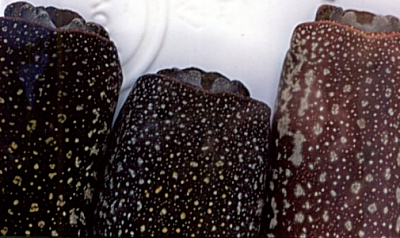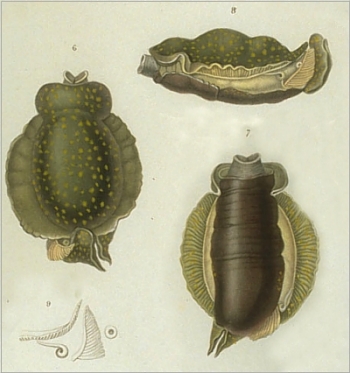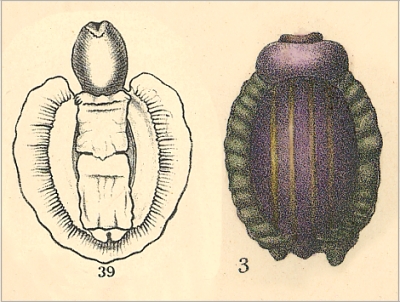The strange Chilean 'sinistrobranch' Posterobranchaea
March 15, 2007
From: Michael Schroedl


Following on from my messages about Navanax aenigmaticus [#19659, #19658] here is some background information about a puzzling animal from Chile which may be the same species.
There seems to be only one historic record of a cephalaspidean from Chile which lacks an external shell. D'Orbigny (1835-46) described the "bizarre" Posterobranchaea maculata new genus, new species from a few, or perhaps just a single specimen, dredged from muddy sand at a depth of nearly 30 m; off Valparaiso. The specimen was 3 cm long but quite wide (2 cm), and the original drawings indicate the body was somewhat contracted. D'Orbigny ( pages 201-203) emphasized the "unique" left-sided position of a posterior gill, anus, genital organs and opening (figs. 6-10), leading him to establish a new higher group, Sinistrobranchia, to distinguish it from all other tectibranchs which have these organs and openings on the right side. Further "anomalies" of P. maculata included a "foot" that is transversally divided into two portions, the larger posterior portion forming a bifid tail, and a pleurobranchid-like large "mantle" with a wide brim except at its most anterior. From a modern perspective it is funny to follow D'Orbigny's explanations and reasoning, since he just had to turn his specimen over, so it was the right way up, to resolve all his problems and obtain a normal aglajid sea slug. He obviously was not aware of the externally similar Mediterranean Aglaja tricolorata Renier, 1807 (or its synonym Doridium membranaceum Meckel, 1809). It was not until later that the bulk of aglajid species were discovered and described.
Rudman (1974) related the central Chilean Posterobranchaea maculata to the Aglajidae, with unknown generic position. The closest record of an aglajid to Valparaíso was the Panamic Navanax aenigmaticus. Gosliner (1980, 1991) feared that P. maculata could be a senior synonym of Navanax aenigmaticus and if so, it would mean that the older generic name Posterobranchaea D'Orbigny, 1837 would have priority over the established Navanax Pilsbry, 1895. Our finding of N. aenigmaticus near Antofagasta, Chile, reduces the distance to Valparaíso to hardly 750 km. More important, N. aenigmaticus is obviously able to inhabit places within the cool Humboldt Current system.
Does P. maculata actually refer to N. aenigmaticus? Opisthobranch illustrations given in D'Orbigny's atlas are not always quite realistic (see Schrödl, 2003). There is no eastern Pacific opisthobranch that would match the drawings of P. maculata [see middle photo - d'Orbigny, Pl 17, figs 6-9] accurately. As reflected by the specific name, the greenish brown foot (as "mantle") has irregular "beautiful sulphur-yellow" spots along the sole; this fits with two of three specimens of N. aenigmaticus found at the northern Chilean Juán López showing yellow spots on the foot sole and whitish spots more laterally; the third one has whitish spots only [see upper photo, and message #19659]. The outer parapodial areas and sides of the body are more brightly coloured than in d'Orbigny's illustrations. D'Orbigny described the head shield and notum (his "divided foot") as entirely blackish brown. However, the drawings (figs. 7, 8) show soome marginal yellow spots or marbling. All specimens from Juán López showed at least some whitish patches on head shield, visceral shield and lobes; however, one specimen was nearly completely blackish brown. D'Orbigny considered the terminal lobes as part of the "foot", but gave them the colour of what he thought was the mantle. D'Orbigny did neither mention nor does the drawing indicate the presence of blue parapodial spots. In conclusion, it is still not proven but more than likely that Posterobranchaea maculata refers to Navanax aenigmaticus, which then would be the single aglajid known from the south-eastern Pacific and would need nomenclatural protection.
-
D'Orbigny, A. 1835-1846. Voyage dans l'Amérique Méridionale exécuté pendant les années 1826-1833. Vol. 5. Mollusques. Libraire de la Société geologique de France:
-
Gosliner, T.M. 1980. Systematics and phylogeny of the Aglajidae (Opisthobranchia: Mollusca). Zool. J. Linn. Soc., 68: 325-360.
-
Gosliner, T.M. 1991. The opisthobranch gastropod fauna of the Galápagos Islands. [In:] Topics in Geobiology, Vol. 8. Galapagos marine invertebrates: taxonomy, biogeography, and evolution in Darwin's islands (James, M.J., ed.). Xiv + 474 pp. Plenum Press, New York, London.
-
Rudman, W.B. 1974. A comparison of Chelidonura, Navanax and Aglaja with other genera of the Aglajidae (Opisthobranchia: Gastropoda). Zool. J. Linn. Soc., 54: 185-212.
-
Schrödl, M. 2003. Sea slugs of southern South America. Conchbooks, Hackenheim. 165 pp.
Michael Schrödl
schroedl@zi.biologie.uni-muenchen.de
Schroedl, M., 2007 (Mar 15) The strange Chilean 'sinistrobranch' Posterobranchaea. [Message in] Sea Slug Forum. Australian Museum, Sydney. Available from http://www.seaslugforum.net/find/19660
Dear Michael,
I like a good detective story. Many of these old names raises the question of just how much of the very old literature and old names we should protect? In this case bergh's description of N. aenigmaticus is probably no better than d'Orbigny's description of P. maculata I guess the debate over whether the 'oldest name' should remain sancrosanct at all costs will always be with us.
I've included a couple more relevant old illustrations. They don't solve anything but thought they were part of the story. Both are from Pilsbry's 1896 volume, a great resource for copies of even older illustrations.
FIGURE: Left: Navarchus aenigmaticus Bergh, 1893 [from Pilsbry, 1896: Pl. 6, fig. 39. Right: Posterobranchaea orbignyana Rochebrune, 1881 [from Pilsbry, 1896: Pl. 54, fig 3]
It is interesting to compare d'Orbigny's illustrations of his species with Bergh's illustration of the preserved specimen of N. aenigmaticus on which he based the species [left]. In his specimen the buccal bulb has popped out of the body, but apart from that it could be the same animal - or quite a few other aglajids I guess. I noticed that Gosliner (1980) mentioned another species Posterobranchaea orbignyana which he said was based on a specimen also from northern Chile, and it had yellow lines. On checking I find it reported not from Santiago in Chile, but Santiago Island in the Cape Verde Islands in the East Atlantic. I have no idea what it is, but it would be a strange coincidence if it turned out to be Edmunds C. nyanyana from Ghana, which we think is probably N. aenigmaticus. As Gosliner notes, two other names from the Caribbean, Doridium gemmatum Morch, 1863 and Doridium punctilucens Bergh, 1893 with black lines and green spots could well apply to the typical Caribbean colour form of N. aenigmaticus. It seems to me that the only way to protect the genus name Navanax and the species name N. aenigmaticus is for someone to prepare a submission to the International Commission. The question of what to call the Atlantic form can only be resolved after a decision is reached on whether it is the same species as the East Pacific species or not.
- Pilsbry, H.A. (1896) Manual of Conchology; Structural and Systematic with Illustrations of the Species. [Ed: G.W.Tryon] Vol. 16, 251pp, Pls 1-71.
- Rochebrune, A.T. (1881) Matériaux pour la faune de l'Archipel du Cap Vert. Nouvelle Archives du Museum National d'Histoire Naturelle, Paris, series 2, 4: 215-340, pls. 17-19.
- Rochebrune, A. T. (1882) Diagnoses d'espèces nouvelles pour la faune de l'Archipel du Cap-Vert. Bulletin de la Société Philomathique de Paris, series 7, 6: 24-32.
Best wishes,
Bill Rudman
Related messages
-
Chilean Navanax aenigmaticus
From: Michael Schroedl, March 14, 2007 -
West African Navanax aenigmaticus
From: M. Schroedl, P. Ryall, T. Gertin, T. Neusser, March 14, 2007 -
Navanax aenigmaticus from Brazil
From: Wagner Torres, June 14, 2005 -
Navanax aenigmaticus from Brazil
From: Vinicius Anderson, November 15, 2003 -
Navanax aenigmaticus from Jamaica
From: Ross W. Gundersen, October 18, 2003 -
Navanax aenigmaticus from Caribbean
From: Nestor E. Ardila, March 5, 2003 -
'Aglaja evelinae' from Belize
From: Dave Behrens, October 11, 2002 -
Navanax aenigmaticus from Costa Rica
From: Peter Ajtai, May 25, 2002 -
Feeding behaviour of Navanax aenigmaticus
From: Alicia Hermosillo, May 14, 2002 -
Color variation of Navanax aenigmaticus
From: Alicia Hermosillo, March 9, 2002 -
Ink from Navanax aenigmaticus
From: Elianny Domínguez Tejo, June 9, 2001 -
Navanax inermis in Brazil?
From: André Mazeron, February 20, 2001 -
Navanax aenigmaticus synonymous?
From: Phanor Montoya, February 5, 2001 -
Information on Navanax aenigmaticus
From: alecia, January 21, 2001 -
Navanax aenigmaticus from Colombia.
From: Phanor Montoya, October 3, 2000
